
The Distinguished Service Medal (DSM) was a military decoration awarded until 1993 to personnel of the Royal Navy and members of the other services, and formerly to personnel of other Commonwealth countries, up to and including the rank of Chief Petty Officer, for bravery and resourcefulness on active service at sea.

The Defense Meritorious Service Medal (DMSM) is an award bestowed upon members of the United States military by the United States Department of Defense. In the order of precedence of the United States Armed Forces, it is worn between the Purple Heart and the Meritorious Service Medal. The medal is awarded in the name of the Secretary of Defense to members of the Armed Forces who, while serving in a joint activity, distinguish themselves by non-combat outstanding achievement or meritorious service, but not of a degree to warrant award of the Defense Superior Service Medal.
The Antarctica Service Medal (ASM) was established by the United States Congress on July 7, 1960 under Public Law 600 of the 86th Congress. The medal was intended as a military award to replace several commemorative awards which had been issued for previous Antarctica expeditions from 1928 to 1941. With the creation of the Antarctica Service Medal, the following commemorative medals were declared obsolete;
The Indian Campaign Medal is a decoration established by War Department General Orders 12, 1907. The medal was retroactively awarded to any soldier of the U.S. Army who had participated in the American Indian Wars against the Native Americans between 1865 and 1891.

The World War I Victory Medal was a United States World War I service medal designed by James Earle Fraser.
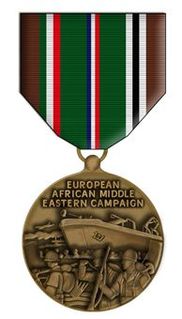
The European–African–Middle Eastern Campaign Medal is a military award of the United States Armed Forces which was first created on November 6, 1942 by Executive Order 9265 issued by President Franklin D. Roosevelt The medal was intended to recognize those military service members who had performed military duty in the European Theater during the years of the Second World War.

The Queen Elizabeth II Coronation Medal is a commemorative medal instituted to celebrate the coronation of Queen Elizabeth II on 2 June 1953.

The Military Merit Medal was a military decoration of the Empire of Austria-Hungary. It was founded by Emperor Franz Joseph I on March 12, 1890. The Military Merit Medal is often referred to as the "Signum Laudis" after the inscription on the reverse of the medal.
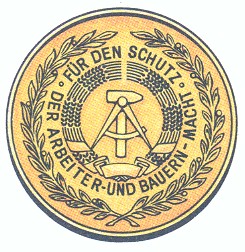
The Medal For Faithful Service in the National People’s Army was a medal issued in the German Democratic Republic (GDR).
The Army Gold Medal (1808–1814), also known as the Peninsular Gold Medal, with an accompanying Gold Cross, was a British campaign medal awarded in recognition of field and general officers' successful commands in campaigns, predominantly the Peninsular War. It was not a general medal, since it was issued only to officers whose status was no less than that of battalion commander or equivalent.
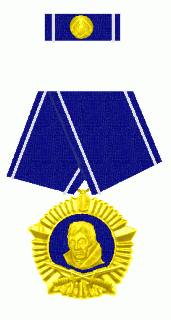
The Scharnhorst Order was the highest medal awarded to members of the East German National People's Army (NVA). It was given for services to military or other strengthening of the German Democratic Republic (GDR). Established on 17 February 1966 by the Council of Ministers of the GDR, it was awarded until the dissolution of the GDR in 1990.

The Medal for voluntary military service is a French military decoration established on 13 March 1975 by decree 75-150. It was established in three grades to recognize voluntary military service in the reserves.

The Medal for Exemplary Border Service was a national award issued in the German Democratic Republic (GDR). It was established on 28 May 1954, by the Council of Ministers of the GDR with Order No. 47/54 from the Ministry of Interior on 16 June 1954. The first presentation ceremony took place on 1 July 1954, to members of the German Border Police.

The Abyssinian War Medal was awarded for service between 4 October 1867 and 19 April 1868 to those who participated in the 1868 Expedition to Abyssinia. This punitive expedition, led by Lieutenant-General Sir Robert Napier, was carried out by armed forces of the British Empire against the Ethiopian Empire. Emperor Tewodros II of Ethiopia, imprisoned several missionaries and two representatives of the British government. The punitive expedition launched by the British in response required the transportation of a sizable military force hundreds of miles across mountainous terrain lacking any road system.

The Polish Army Medal was established by Poland on 3 September 1999 to recognize service to the Polish Army by foreign civilians and military personnel. The medal is presented in three grades Gold, Silver, and Bronze by the Polish Minister of National Defence. Most awards are presented to members of allied armed forces, but the medal is also awarded to civilians who contribute to promoting the history and traditions of the Polish Army outside of Poland.
The Medal Brotherhood in Arms of the National People’s Army was a medal issued in the German Democratic Republic (GDR).
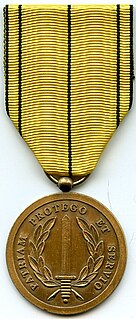
The Medal for Services Rendered is a Belgian military service medal that was proposed to be created on 18 April 1988 by ministerial decree. It was intended to be awarded to members of the army, navy, air force and medical services of the Belgian Armed Forces for service rendered in particularly difficult circumstances over an extended time period. However, the creation of the medal was presented to the Council of State under the form of a ministerial decree and the Council ruled that the creation of such an award should be done by the King, thus via a Royal Decree. As a Royal Decree was never made, the medal was never officially created and has not or cannot be awarded.

The Honour medal of railroads is a state decoration bestowed by the French Republic in the form of an honour medal for work. It was originally meant to reward, depending on the quality and length of time calculated in calendar years, the services rendered by French agents and labourers and to nationals of the French Union or protectorates, in service with the railroads. The Honour medal of railroads was created by decree on 19 August 1913 as a reward for thirty years of service. Since then, many modifications were instituted by consecutive decrees amending the original text.

The Police Coronation Medal was sanctioned in 1902 as an award to policeman, firemen and members of ambulance units on duty during the official celebrations of the Coronation of King Edward VII and Queen Alexandra on 9 August 1902.
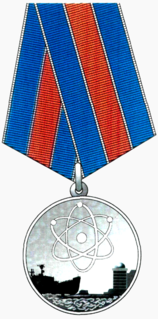
The Medal "For Merit in the Development of Atomic Energy" is a state decoration of the Russian Federation aimed at recognising achievements in the nuclear industry. It was established by presidential decree №133 on March 16, 2015, marking the 70th anniversary of the Russian nuclear industry. The decree also established the title "Honored Worker of the Nuclear Industry of the Russian Federation."























